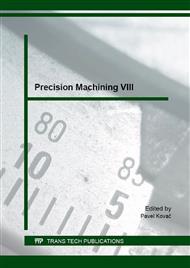[1]
Qian J, Li W, Ohmori, Cylindrical grinding of bearing steel with electrolytic in-process dress. Precis Eng 24(2000): 153-159.
DOI: 10.1016/s0141-6359(99)00040-9
Google Scholar
[2]
Stephenson DJ, Veselovac D, Manley S, Corbett J, Ultra-precision grinding of hard steel. Precis Eng 25(2001): 226-345.
DOI: 10.1016/s0141-6359(01)00087-3
Google Scholar
[3]
Pal B, Chattopadhyay AK, Chattopadhyay AB, Development and performance evaluation of monolayer brazed cBN grinding wheel on bearing steel. Int J Adv Manuf Technol 48(2010): 935-944.
DOI: 10.1007/s00170-009-2341-z
Google Scholar
[4]
Zhang FH, Cao HB, Luan DR, Luo SB, Zhang B, Research on ELID grinding performance of GCr15 steel. Diam Abr Eng (2005): 57-61.
Google Scholar
[5]
Ohmori H, Nakagawa T, Utilization of nonlinear conditions in precision grinding with ELID (electrolytic in-process dressing) for fabrication of hard material components. Ann CIRP 46(1997): 261-264.
DOI: 10.1016/s0007-8506(07)60821-x
Google Scholar
[6]
Ohmori H, Katahira K, Akinou Y, Komotori J, Mizutani M, Investigation on grinding characteristics and surface-modifying effects of biocompatible Co-Cr alloy. CIRP Annals-Manuf Technol 55(2006): 597-600.
DOI: 10.1016/s0007-8506(07)60491-0
Google Scholar
[7]
Fathima K, Senthil KA, Rahman M, Lim HS, A study on wear mechanism and wear reduction strategies in grinding wheels used for ELID grinding. Wear (2003), 1247-1255.
DOI: 10.1016/s0043-1648(03)00078-4
Google Scholar
[8]
H. Ohmori and T. Nakagawa: Annals of the CIRP, Vol. 29(1990), pp.239-332.
Google Scholar
[9]
Zhang KF, Ren CZ, Yang LJ, Precision grinding of bearing steel based on active control of oxide layer state with electrolytic interval dressing. Int J Adv Manuf Technol (2012): 411-419.
DOI: 10.1007/s00170-012-4180-6
Google Scholar
[10]
Yang LJ, Ren CZ, Jin XM, Experimental study of ELID grinding based on the active control of oxide layer. J Mat Pro Technol (2010): 1748-1753.
DOI: 10.1016/j.jmatprotec.2010.06.005
Google Scholar
[11]
Shanawaz AM, Sundaram S, Pillai UTS, Grinding of aluminium silicon carbide metal matrix composite materials by electrolytic in-process dressing grinding. Int J adv Manuf Technol (2010): 143-150.
DOI: 10.1007/s00170-011-3288-4
Google Scholar
[12]
Hitoshi Ohmori, Loan D. Marinescu, Lazutoshi Katahira, Electrolytic in-process dressing (ELID) technologies fundamentals and applications. CRC Press. (2011).
DOI: 10.1201/b10973-3
Google Scholar


